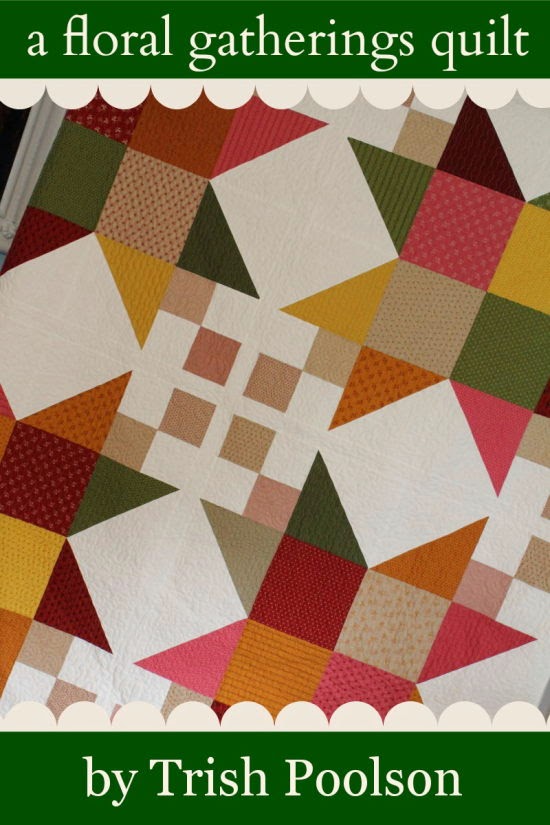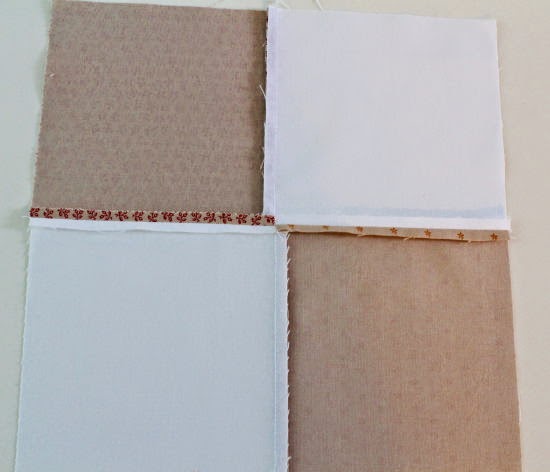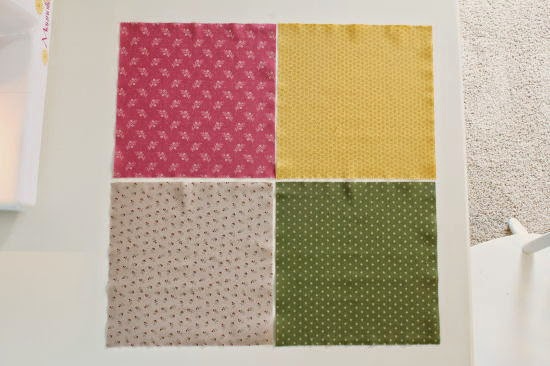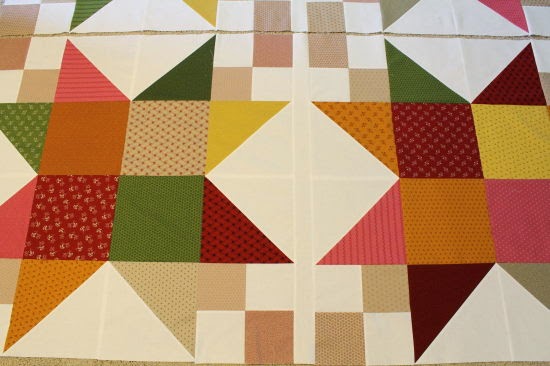
Hello! I’m Polly Monica from Aunt Polly’s Porch! I’m so happy to be posting here today at the always awesome Moda Bake Shop! I fell sewwww in LOVE with Moda’s Sewing Box collection and knew it would make some fun things for organizing any sewing room! I hope you think so, too! Let’s get busy making these eight sewing projects which include a sewing machine cover, a sewing machine mat, a versatile sewing caddy for your ironing board or armchair, a tub cover, a tie on pin cushion, a chatelaine, a square pin cushion and needle book.

1 Sewing Box charm pack
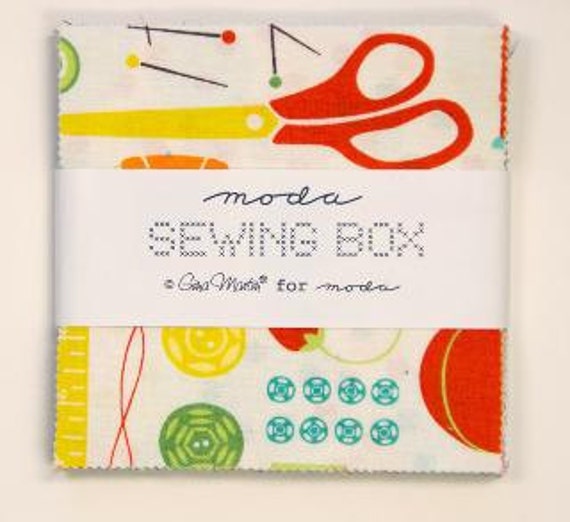
½ yard coordinating print # 1 (notions print white)

½ yard coordinating print # 2 (tape measure multi)

½ yard coordinating fabric #3 (pins lime)

1 yard coordinating print #4 (buttons blue)

1.5 yards fusible fleece

3.5 yards Jumbo rick rack
Assorted colors and sizes of buttons

ABBREVIATIONS and NOTES-
All seam allowances are ¼” unless directed differently.
RST = right sides together
RSO = right sides out
WOF = width of fabric (selvage to selvage)
Sewing Machine Cover Instruction

My sewing machine sits down in a Horne sewing table and it’s measurements are- 16” from right to left, 8 ½” from top of machine to tabletop, and 7 ½” deep looking at the machine from the side. (If your machine sits on top of a table, the height will be taller than mine!) You will need to measure your machine and adjust the measurements as necessary.
Take charm pack and cut all pieces in half, giving you two stacks of 42 pieces – 2 ½” by 5” rectangles.

Set one stack aside, now cut the other stack in half, giving you two stacks of 42 pieces – 2 ½” by 2 ½” squares.

Set one stack aside, take remaining stack of 2 ½” squares and select 16 for each side of the cover.
Lay them out in two rows of eight squares each (16 for each side).
From the leftover squares, select 4 for a four patch that will be made into a square pin cushion
And select 5 squares to be sewn into a row for a long skinny pin cushion.

Sew the two rows of squares for one side together- press seams in one direction on the first row and in the opposite direction for the second row so that the seams will nestle together when joined. The resulting long seam can be pressed to one side or open.

For the center panel on the cover, look at your fabric # 1. If the printed design is directional, like mine was, and you want it to be right side up on both sides of the cover, then you will cut two pieces that are 8 ¾” by 16 ½”. With RST, with the top of the design on BOTH pieces at the top, sew that 16 ½” long seam.

Now your design should be right side up on both sides of that center seam. If your print is NOT directional then you need no center seam and can cut one piece 17” by 16 ½”.
Sew one pieced set on each 16 ½” end. Press those seams toward the center panel.

Cut a piece of fusible fleece and your fabric # 2 for the batting / backing 18 ½” by 27”. Fuse the fleece onto the wrong side of either front or backing. With RSO, pin the sandwich and quilt as desired. I just did an all-over meander design.

If you wish to add rick rack or other trim, do it now! Some folks just stitch down the center of rick rack, which is fine with the narrow ones, but for the jumbo size, I like to sew close to the edge, down each side. Then trim off excess batting/backing.

For the ties, cut one 2 ½” by WOF strip of your fabric #3. Press it in half lengthwise.

Then open it up and fold the two long raw edges into the center fold and press again.

Topstitch closely down each long edge.

Trim off selvage ends, cut it into 4 equal pieces. Lay the cover over your machine and decide where you want the ties to go

and baste them onto the backing side with the raw end edge even with the side of the cover.

For the binding, measure the perimeter of your cover and add 8”. Bind the edges your way! Everybody has their own way of binding . I cut my strips 2 ½” by WOF. I join the strips with a diagonal seam, press in half lengthwise, and sew onto the front of the quilt with a SCANT 3/8” seam allowance, flip binding over the seam to the back and hand sew it down. But, the binding can be done your own way!

If you wish to add a handle at the top of the cover, cut two 2 ¾ ” by 7 ¼”pieces of your fabric #2. Cut one piece of fusible fleece 2 ¾” by 7 ¼”, and fuse onto the wrong side of one fabric piece. If you wish to add rick rack or trim on the handle, sew it onto that piece now.

I wanted my handle to be a bit more narrow at the ends, so I folded the pieces in half and cut off the corners- see pix below.

With RST, sew a ¼” seam all around the handle edges but leave an opening at least 2” to turn it through!

Turn the handle RSO through that opening and hand sew the opening closed. Topstitch 3/8” inch from all edges.

Measure the cover to find the center and mark it with a pin. Center the handle over that center, but build in a gap!

Sew through all layers, attaching the handle to the cover at each end.

I LOVE adding buttons to projects and especially stacking different sized buttons!!

Add them now wherever you want!! You could even add them down the middle of the rick rack, too!!
All done! Now stand back and admire your creation!!

Small Square and Tie-On Pin Cushions

Remember that fourpatch and row of five squares you selected and set aside back when you were picking out the squares for your cover front and back?

If you didn’t sew them together, do it now! Then lay them RST on top of a scrap of your fabric #1 which will be your backing, and cut around them.

Sew around all sides of the fourpatch, leaving a small opening on one side to turn it through.
Clip the seam allowance diagonally across the corners, but not too close!
This will reduce the bulk there and make those corner points look perfect!

Turn it RSO, fill it with your choice of polyfil or crushed walnut filler. I like the latter for pin cushions!!

I get it at the local pet shop- it’s cheap and is actually made for the bottom of small pet cages.
I save my twill tape ties from all Moda jelly rolls and bundles, so I cut my ties for the Tie-On pin cushion from one of those ties. If you don’t have any, you can make ties like the ones you made for the cover from fabric scraps or use ribbon you have in your stash. To determine how long to cut your ties, measure your machine as shown below.

Add 6” to that measurement. My machine measured 24” + 6” = 30”. So I cut a piece of the Moda twill tape 30” then cut that in half. Insert one end of each tie between the long skinny 5 patch and its backing.

Then sew all around the edges, but remember to leave a small opening to turn it through.

Turn it RSO through that opening, pulling out the ties, too. Fill both pin cushions al full as you like. On the skinny one, first fill it only partially up to the second seam line. Stitch through all layers at that seam between the second and third square to facilitate it fitting snugly around the corner on your machine, then fill it the rest of the way.

Sew the openings closed with tiny stitches.

Add stacked buttons in the center of the four patch pin cushion and at the sewn down seam on the tie-on pin cushion.

Voila!! Done!! Yaaaay!!

Tie the Skinny pin cushion onto your machine!! Add pins!
Sewing Machine Mat

Cut a 16 ½” by 16 ½” piece of your fabric #4. Grab your stack of 2 ½” by 5” charm pack pieces, and select 8 pieces. Sew them together along the 5” sides. Press the seams open. Now cut this strip in half lengthwise giving you two strips that are 2 ½” by 16 ½”.

Sew one strip on each side of the fabric square you cut above.

Select 10 more strips, sew them together as described above, press seams open and cut in half. Sew one of the strips across the back of the piece. Set the other strip aside for now.

Now, select 10 more strips for the tall pocket layer, sew them together as above, press seams open, then lay that piece on top of your fabric # 4, and cut a lining strip that exact same size. With RST, sew down one long side. Turn RSO, press and top stitch 3/8” from seam edge.

Lay this pocket strip across the bottom of the mat with raw edges even all around and pin, then baste these raw edges together.

Now, stitch through all layers wherever you want to create individual pockets. Make sure to backstitch at the top edge of each pocket seam.

I made all my pockets the same size by stitching through all layers on every other seam line.

Next, take the half sized strip you set aside above that has 10 squares and cut out a lining for it from your fabric #4, exactly as you did it above. With RST, sew across the top edge, turn it RSO, press and top stitch it 3/8” from edge.

Lay it over the tall pocket strip on the lower edge of the mat, creating a second row of smaller pockets.
Baste the raw edges together on sides and bottom. Then sew through all layers again at seams to create the pockets.

In the photo above, the orange pins show where the tall pockets were stitched and the purple pins show where I chose to sew my smaller pockets. You can sew yours wherever you want!
Use this top to cut a piece of fusible fleece the same size. Iron it onto the wrong side of the finished top. Cut the backing from your fabric #4 just a bit bigger all around than the top. Pin the sandwich and quilt as desired, but don’t quilt through the pockets!!

If you want to add rickrack or trim, sew it on now!!
Trim the edges even and bind as desired using your fabric #3!

Hand sew the binding to the back of the mat! Taadaa!!
Done!! YAY!! Now set your machine on it and fill up those awesome pockets!!
Versatile Caddy

Believe it or not, you still have some leftover 2 ½ strips from your charm pack, and you have scraps from your yardage we’ve been using, which you can cut into a few more 2 ½” by 5” strips if you want more variety!
Select 3 strips for pockets on one end of the caddy and 4 strips for the thread catcher on the other end of the caddy. Sew them together, cut a piece of fusible fleece for the four strip set, and fuse it on the back. Lay them both on your fabric #4, and cut a matching lining piece for each.

With RST, sew one long side together on both, turn both RSO, press seams and topstitch 3/8” from seam edge. On the four strip piece with the fleece inside, quilt it as desired.

Set both aside for the moment!
Cut 2 pieces 6 ½” by 18” from fabric # 4, and one piece the same size from fusible fleece.

Fuse the fleece on the wrong side of one piece. Layer RSO, then quilt as desired, creating the caddy base.

Align the three strip piece at one end and baste the raw edges on all three sides.

Then stitch through all layers on the 2 seam lines to create 3 pockets. Backstitch at the top of each pocket seam.

Align then baste the SIDES of the four strip set at the other end of the caddy base. Then pin the center bottom of the four strip piece to the center of the bottom of the caddy base and then make two small pleats as you pin the rest of the bottom edge of the four strip piece to fit the base.

Then baste across the bottom edge.

If you wish to add rickrack or trim, add it now!

Trim edges even and bind with fabric #3. Set aside.
Select 6 leftover 2 ½” by 5” strips for the caddy pin cushion.
Cut them in half creating 12 squares 2 ½” by 2 ½”.

Arrange them in two groups of 6 and sew each group together, leaving a small opening in the center seam of one group to use to turn it through later.

Place the two pieces RST, and using a ruler and pen, draw a line 1” in from each corner point and trim those corners off.

Now, sew all around the edges. Turn it RSO through the opening in the bottom seam.

Fill the pin cushion with polyfil or crushed walnuts and handstitch the opening closed.

I cut an 8” piece of rickrack and hand stitched/gathered one long edge and drew the thread up to create a ruffled flower.

I hand stitched it to the center of the pin cushion and added some stacked buttons, as well.

You can embellish your pin cushion as desired! Center the pin cushion in the middle of the caddy and hand stitch it through the back side to the caddy. YESSSSSSSS! All done!!

Now you can use it on the end of your ironing board and on an armchair in front of the TV!!
Tub Cover

I wanted a tub to sit on my sewing table for sewing tools and materials. I had a large plastic 16 ounce Cool Whip tub container that was the right size! The circumference was 18” and the height was 5”.

Using the stack of leftover 2 ½” by 2 ½” square charm pack pieces, select 20 pieces and arrange and sew them together in two rows of ten squares.

If you want to add rickrack or trim, do it now!! I added rickrack down the center seam line.
Cut and fuse a matching piece of fleece to the back of it, then quilt it as desired. I grid-quilted it.

Cut a matching piece of fabric #4 for the lining, but make one end about an inch longer. Also, just a note here that for backings and lining and even batting/fleece, you can piece smaller scraps together when needed. I save small pieces of batting and connect them with fusible batting tape.

You will see this tape on the back of this tub cover!

Another tip is to trim off corners of seam allowance at points, as shown in photo below, to make them turn RSO better.

Sew two long sides and one short end seams- leaving open the short end with the longer lining piece.
Turn the cover RSO, topstitch 3/8” from the edges and fold up the longer lining end to enclose the raw edges and stitch it closed.

Pin the cover TIGHTLY around the tub, then slide it off. Sew it closed on the topstitch line of the finished end. I added a stack of buttons for embellishment, then slid it back onto the tub.

Another little project complete!! Yahoo!!
Sewing Chatelaine

Line up 18 to 22 of your leftover 2 ½” squares in a long row. (Don’t forget you have some yardage scraps you can cut into 2 ½” squares to supplement your leftovers and provide a bit more variety.)

Sew them together, press the seams open then press it in half lengthwise

and use the same technique you used above to create the sewing machine cover ties to make a long topstitched piece.

Fold in one short raw edged end as you topstitch it, and slip in a 2” loop created from a bit of stash ribbon or thinner rick rack as I did.

Knot the other raw edged end.

Set aside for now. Select a green 2 ½” square, fold it in half then in half again and cut into a petal shape using pinking shears if you have them,

if not, just use regular scissors. Cut carefully from between two petals just to the center of the piece. Set aside for the moment.

Select 8 more 2 ½” squares and sew them into four patches. Lay them RST, and trim off the bottom corners creating a triangular shape with the narrow end at the bottom. This will become your strawberry shaped pin cushion. Sew all around leaving the top open. Using needle and doubled thread, sew a gathering stitch around the open top edge.

Turn RSO, and stuff with polyfil. Push the knotted end of the finished strip down into the polyfil and draw up the thread- gathering the raw edge tightly inside around the strip. Secure it with stitches and a secure hidden knot.

Wrap the leaf piece around the top of the strawberry and hand stitch it there.

Add some pins and needles, if desired!!

Sew on a small button a few inches in from the loop at the other end, so you can secure your small scissors there!! Well done! Another part of the set is complete!! You can wear your chatelaine around your neck while doing hand sewing in your favorite chair in front of the TV and never lose your scissors between the cushions again!!

Needlebook

After all this, I still had a few leftover 2 ½” by 5” strips, and I cut two more from yardage scraps.
Sew the four strips together. Cut and fuse a matching piece of fleece to the wrong side. Quilt as desired. Add trim or rickrack if you desire. Cut a 4” piece of stash ribbon or thin rickrack, fold into a loop and baste on the center of the back.

Cut a matching piece of fabric #4, or other yardage scrap, for the lining. With RST, sew around the edges leaving a small opening for turning.

Turn it RSO, hand sew the opening closed then topstitch around all edges.

Cut three 4” by 6 ¾” pieces of scrap batting .
Draw a line down the center with a heat erasable pen.

Line up this drawn line with the center seam of the cover.

Carefully flip it over and sew down the center seam from the cover side and through all thicknesses.

Erase the drawn line on the batting with a hot iron. Fold the book on that center seam line.
Add a button or two on the front allowing it to be secured with the loop from the back!

Add some needles inside and that’s it! You have completed the set of eight projects in this pattern collection!!

Pat yourself on the back and enjoy using your new sewing room creations!!


Eight sewing room essentials including a Sewing machine cover, a square pin cushion, a tie on pin cushion, a versatile caddy, a sewing machine mat, a tub cover, a chatelaine, and a needle book!
Thanks ever so much for trying out these projects! You may have spotted my sweet Westie – Yogi, in some of the photos!

Come visit us soon at my blog- www.auntpollysporch.blogspot.com!!
We’d love to have you come and visit!!
Polly Monica
{www.auntpollysporch.blogspot.com}

































































































